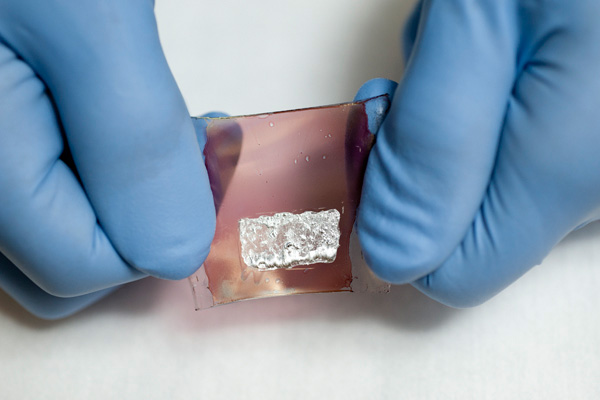A Stanford University researcher has developed a flexible sensor that is so sensitive to the pressure applied to it that it can sense a fly landing on it. Now the researcher is trying to add to the sensor the ability to detect chemicals and different types of biological molecules as well as make it turn itself on using polymer solar cells. The innovative solar cells are not only flexible, but also stretchable - they can be stretched up to 30% beyond their original length without any fear of losing their efficiency.

"Using artificial skin, we can basically introduce any function we are interested in," said the researcher, a professor of chemical engineering. "This is why I call our skin "super-skin". It's beyond what we know as normal skin."
The basis of the artificial skin is a flexible organic transistor composed of flexible polymers and carbon-based materials. To also add touch sensing capability, the transistor contains a very thin elastic rubber layer made up of a dense network of inverted pyramids. When pressure is applied to this layer, it changes its thickness and consequently the current passing through the transistor changes. The sensors contain an amount of between hundreds of thousands and up to 25 million pyramids per square centimeter, depending on the degree of sensitivity desired.
In order to "sense" a certain biological molecule, the surface of the transistor must be coated with another molecule that binds to the target molecule when the two come into contact with each other. The coating layer should have a thickness of one or two nanometers.
"Depending on the type of material in which we coat the transistor and the type of semiconductor material found in the transistor, we can adjust the sensor so that it can detect specified chemicals or biological substances," the researcher points out.
The research team successfully demonstrated the scientific concept by detecting a specific type of DNA. The researchers are currently working on expanding the method so that it can detect proteins and be used for medical diagnosis purposes. "Each and every disease has, in most cases, one or more specific proteins involved in it - proteins called biomarkers - which constitute a kind of "smoking gun" or a suspicious hint of the disease, so that locating these biomarkers will allow doctors to diagnose the disease effectively," explains the researcher . The same approach will allow the sensors to detect chemicals as well - by adjusting the structure of the "super skin" transistor, it can be used to detect chemicals in liquid or gaseous environments.
Regardless of the type of materials the detectors are supposed to detect, they must emit electrical signals in order to transmit the information to a processing center, whether it be the human brain or a computer. By operating the sensors with solar energy, supplying the required energy is simpler than using batteries or connecting them to the electrical system, and this also allows the sensors to be lighter and more portable. Beyond that, the preparation of stretchable solar cells opens the door to additional applications.
In the article, published in the scientific journal Advanced materials, they demonstrate how the cells can be stretched in one direction, but the lead researcher notes that since the publication date they have been able to get stretching along two axes. The cells are composed of wavy microstructures that expand, accordion-like, when stretched. A liquid metal electrode fits into the corrugated surface of the device in its two states - both stretched and contracted.
"One of the applications where stretchable solar cells could be useful would be in fabrics and fibers for uniforms and other clothing," notes one of the researchers. "There are areas of the human body, such as the elbow, where movement causes the skin and clothing to stretch," explains the researcher. "A device that is only flexible, and which lacks the ability to stretch, would break in such a case. "The ability to stretch will be useful for connecting solar cells to curved surfaces, without fear of breaking or folding, such as in external systems of vehicles, lenses and objects used for design and construction. The solar cells continue to generate electricity even in their tense state while receiving a continuous flow of electricity used to transmit the information from the sensors.
The lead researcher refers to Super Skin being developed as more than an excellent imitation of human skin; It could allow robots, or other devices, to perform actions that go beyond what human skin is capable of.
"It is possible to imagine a robotic hand that can be used to touch a certain liquid and locate specific markers or proteins associated with various diseases while indicating the type of disease," explains the researcher. "Or such a hand could touch the sweat dripping from a certain person and determine whether he is drunk or not."
In addition, the researchers were able to replace the materials used in early versions of the transistor with biodegradable materials. Such a super skin system would not only be more versatile and powerful, but it would also be more environmentally friendly.

2 תגובות
The next thing - artificial intelligence
זה מדהים!